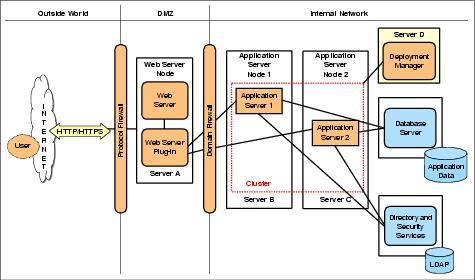
Horizontal scaling exists when the cluster members are located across multiple machines. This lets a single application span over several machines, yet still presenting the application as a single logical image. Figure 3-9 illustrates a horizontal scaling topology with two Application Server Nodes, each one on a separate machine (Servers B and C). Notice that there is a fourth server, Server D, where the Deployment Manager is installed to manage the cluster.
The Web server plug-in distributes requests to the cluster members on each node and performs load balancing and failover. If the Web server (Server A) goes down, then the WebContainer Inbound Chain of Server B or C could be utilized (limited throughput) meanwhile Server A or the Web server on Server A is repaired.
Be aware that this configuration introduces a single point of failure; when the HTTP server is out of service, your entire application is inaccessible from the outside network (internal users could still access the appserver(s) using the WebContainer Inbound Chain). You can omit this SPOF by adding a backup Web server.
If any component in the Application Server Node 1 (hardware or software) fails, the Application Server Node 2 can still serve requests from the Web Server Node and vice versa.
The Load Balancer, part of the WebSphere Edge Components, can be configured to create a cluster of Web servers and add it to a cluster of appservers. This is shown in 3.8, Horizontal scaling with IP sprayer topology.